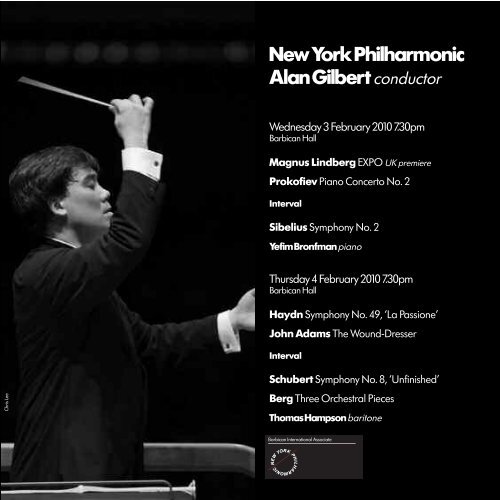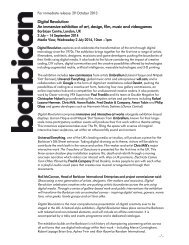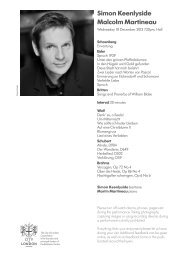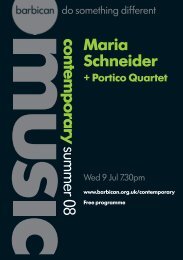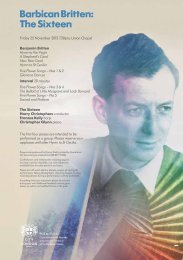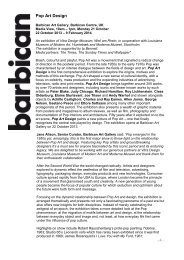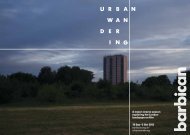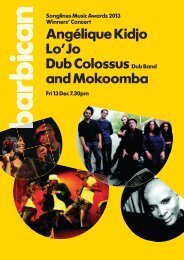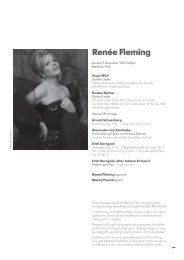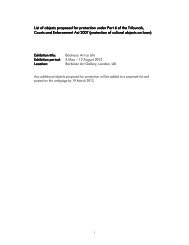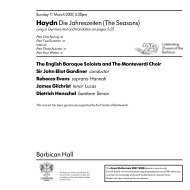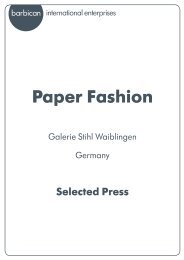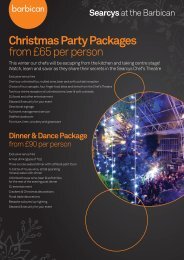Download your concert programme here - Barbican
Download your concert programme here - Barbican
Download your concert programme here - Barbican
You also want an ePaper? Increase the reach of your titles
YUMPU automatically turns print PDFs into web optimized ePapers that Google loves.
New York Philharmonic<br />
Alan Gilbert conductor<br />
Wednesday 3 February 2010 7.30pm<br />
<strong>Barbican</strong> Hall<br />
Magnus Lindberg EXPO UK premiere<br />
Prokofiev Piano Concerto No. 2<br />
Interval<br />
Sibelius Symphony No. 2<br />
Yefim Bronfman piano<br />
Thursday 4 February 2010 7.30pm<br />
<strong>Barbican</strong> Hall<br />
Haydn Symphony No. 49, ‘La Passione’<br />
John Adams The Wound-Dresser<br />
Interval<br />
Chris Lee<br />
Schubert Symphony No. 8, ‘Unfinished’<br />
Berg Three Orchestral Pieces<br />
Thomas Hampson baritone
Wednesday 3 February<br />
Magnus Lindberg (born 1958)<br />
EXPO (2009) UK premiere<br />
Magnus Lindberg, who is beginning a two-year<br />
appointment as the New York Philharmonic’s composer-inresidence,<br />
emerged on the international music scene in the<br />
1980s, one of a handful of Finnish composers of his<br />
generation that included Kaija Saariaho, Jouni Kaipainen,<br />
and Esa-Pekka Salonen. All four studied with the same<br />
teacher at the Sibelius Academy in Helsinki, the renowned<br />
composer and pedagogue Paavo Heininen. Lindberg also<br />
worked with another senior eminence of Finnish music, the<br />
composer Einojuhani Rautavaara.<br />
Lindberg and Salonen were close colleagues during their<br />
student years, and together they founded Toimii, an<br />
instrumental ensemble that not only championed modern<br />
music but also helped both composers investigate novel<br />
instrumental possibilities and compositional procedures.<br />
Lindberg was also active as a pianist, appearing in <strong>concert</strong><br />
and on recordings, especially in contemporary repertoire. In<br />
1981 he left Finland for Paris, w<strong>here</strong> he studied with Vinko<br />
Globokar and Gérard Grisey. Other formative training<br />
came from Franco Donatoni (in Siena), Brian Ferneyhough<br />
(in Darmstadt), and at the EMS Electronic Music Studio (in<br />
Stockholm). His work has been honoured with such awards<br />
as the UNESCO International Rostrum for Composers (1982<br />
and 1986), the Prix Italia (1986), the Nordic Council Music<br />
Prize (1988), the Royal Philharmonic Society Prize (1993) and<br />
the Wihuri Sibelius Prize (2003).<br />
During the 1980s Lindberg’s music revealed its composer’s<br />
penchant for complexity, a trait that led him to be<br />
uncompromising in the difficulties he sets before his<br />
musicians. ‘Only the extreme is interesting’, Lindberg<br />
proclaimed. ‘Striving for a balanced totality is nowadays an<br />
impossibility … an original mode of expression can only be<br />
achieved through the marginal – the hypercomplex<br />
combined with the primitive.’ As the decade unrolled,<br />
Lindberg grew increasingly preoccupied with the intricacies<br />
of rhythmic interaction on multiple levels; this led to the<br />
composition, in 1983, of his Zona for solo cello and chamber<br />
ensemble. Zona – Lindberg favours short, single-word titles –<br />
brought his investigations of rhythmic complexity to the<br />
practical limit of the unaided human mind, so for his next<br />
major work, the award-winning Kraft (for orchestra plus an<br />
ancillary ensemble that plays on both traditional musical<br />
instruments and such ‘found’ objects as chair legs and car<br />
springs), he devised a computer program to assist in<br />
generating more meticulous calculations to fuel his<br />
composition. Other computer programs would follow,<br />
always keeping up with advances in technology.<br />
In the course of music history, composers drawn towards<br />
stylistic complexity have often arrived at a breaking-point<br />
and then moved on to a soundworld that (at least from the<br />
outside) appears far simpler. Similarly, following the intense<br />
difficulty of Zona and Kraft Lindberg proceeded to<br />
2
Wednesday 3 February<br />
soundscapes that, in many cases, seem more relaxed and<br />
less insistently close to overload; some might even be<br />
described as smooth or spacious. That said, many of<br />
Lindberg’s scores, even those in the modern ‘classicist’<br />
mode, remain generally vigorous, colourful, dense and<br />
kinetic and, despite the extreme refinement of his<br />
compositional method, his scores manage to sound very<br />
spontaneous.<br />
Although he has worked in a variety of genres, Lindberg has<br />
carved out a particular reputation as a composer of<br />
orchestral music. ‘The orchestra’, he has declared, ‘is my<br />
favourite instrument.’ Symphonic works of the past decade<br />
or so include Feria (whose American premiere was given by<br />
the New York Philharmonic in 1997, conducted by Jukka-<br />
Pekka Saraste), a Concerto for Orchestra (2002) and<br />
<strong>concert</strong>os for cello (1999), clarinet (2002) and violin (2006).<br />
Among his most recent works is Seht die Sonne (‘Behold the<br />
Sun’), jointly commissioned by the Berlin Philharmonic and<br />
the San Francisco Symphony, and described in the Financial<br />
Times as ‘an extravagant and glittering piece on a grand<br />
scale’. These scores reveal Lindberg’s increasing interest in<br />
presenting clear-cut melody, sometimes even of a folkish tint,<br />
underscoring that even after composing some 80 works he<br />
continues to develop an idiosyncratic path of personal<br />
creative discovery.<br />
About EXPO – Magnus Lindberg’s first work written for the<br />
New York Philharmonic and also the first piece that Alan<br />
Gilbert conducted as the Orchestra’s Music Director, on<br />
16 September 2009 – the composer has offered the<br />
following thoughts:<br />
‘The title is self-explanatory; it’s the exposition of Alan’s<br />
season. I work with extremely strong contrasts, setting up<br />
some contrasts between super-fast and super-slow music<br />
and then a strange amalgam between these poles. It’s a<br />
piece built on qualities I find so gorgeous in Alan’s way of<br />
making music – absolute technical and physical straightness,<br />
no mystery around the rational part of it, and then on top of<br />
that the highly irrational and mysterious part of how you<br />
actually put music together.<br />
Given the brevity of the piece – 9 or 10 minutes – I thought a<br />
pithy word such as “EXPO” would make a fitting title;<br />
besides, I like the sound of the word. A work of any length<br />
must have a trajectory, a sense of direction and logic about<br />
the way it evolves. I have tried to establish a musical<br />
language to communicate this drama. As short as EXPO is,<br />
t<strong>here</strong> are more than 10 tempo markings, resulting in a<br />
feeling of great tension and energy in the orchestra.’<br />
Programme note © James M. Keller, New York Philharmonic<br />
Program Annotator<br />
3
Wednesday 3 February<br />
Sergey Prokofiev (1891–1953)<br />
Piano Concerto No. 2 in G minor, Op. 16 (1912–13)<br />
1 Andantino<br />
2 Scherzo: Vivace<br />
3 Intermezzo: Allegro moderato<br />
4 Allegro tempestoso<br />
Yefim Bronfman piano<br />
Prokofiev was a born show-off and a born competitor, and<br />
his music demonstrates that time and again – not necessarily<br />
in aggressive or unpleasant ways, though that side of his<br />
nature certainly surfaced from time to time, but rather in his<br />
fondness for telling stories, for casting magic spells, for<br />
demonstrating gymnastic, sporty and especially balletic<br />
prowess. Those are all qualities calculated to hold an<br />
audience in thrall, and they combined to make him a natural<br />
for the <strong>concert</strong>o medium.<br />
His Second Piano Concerto gives the fullest possible rein to<br />
all these gifts. He composed it in 1912–13, just before his<br />
graduation from the St Petersburg Conservatoire, primarily<br />
as a vehicle for his own virtuosity, and many would rate it by<br />
some distance the most technically demanding of all<br />
<strong>concert</strong>os in the standard repertoire. Though Prokofiev never<br />
admitted as much, it would not be surprising had he been<br />
deliberately aiming to outdo Rachmaninov’s massive Third<br />
Concerto, which was published and first performed in Russia<br />
in 1910. Prokofiev’s score was destroyed by fire at the time of<br />
the 1917–21 Civil War in the early days of Bolshevik rule. He<br />
reconstructed and reorchestrated it in his voluntary exile,<br />
during a stay in Bavaria in 1923.<br />
The deceptively lulling first theme is marked narrante<br />
(narrating), just as Rachmaninov’s plainer opening theme<br />
could easily have been. But this story proves to be not one of<br />
Rachmaninovian nostalgia and longing, nor of heroism and<br />
triumph, nor even one in which the soloist becomes<br />
emotionally embroiled. Rather it is in essence a fairytale,<br />
populated by larger- and stranger-than-life characters,<br />
unfolding in a world of mythical castles, potentates,<br />
hobgoblins and sundry grotesques. It asks us to suspend<br />
disbelief and look on in childlike awe.<br />
4
Wednesday 3 February<br />
The pianist is cast in the role of spell-master and illusionistin-chief,<br />
conjuring up undreamt-of beings and making<br />
them dance to his tunes, sometimes commanding the whole<br />
charade to cease so that he can take every role himself, as in<br />
the hypertrophic first-movement cadenza. Like the massive<br />
cadenza in the original version of Rachmaninov’s Third, this<br />
one occupies the structural place of a sonata recapitulation.<br />
The opening theme then closes the narrative frame,<br />
providing just a few seconds of calm for the soloist to<br />
regain composure.<br />
Then we are straight into a two-and-a-half-minute perpetualmotion<br />
Scherzo, consisting of no fewer than 1504 continuous<br />
semiquavers, challengingly laid out in parallel motion<br />
between the hands. Here the soloist doubles, in effect, as<br />
juggler and contortionist. The third movement is nominally an<br />
Intermezzo, but in character it comes across more like a<br />
grotesque march. Its extravagant gestures reminded<br />
Sviatoslav Richter of ‘a dragon devouring its young’, though<br />
when all is said and done perhaps this is only a pantomime<br />
dragon.<br />
For all the hand-flinging antics in the finale’s early stages, it<br />
contains more reflective episodes than the previous two<br />
movements. Two of these episodes have the makings of solo<br />
cadenzas, but neither grows to the monstrous dimensions of<br />
their counterpart in the first movement. Prokofiev was rarely<br />
one to strain himself unduly over such matters as structural<br />
transition, but the way he lets the second solo episode<br />
edge back towards the main theme is a compositional<br />
masterstroke. However, t<strong>here</strong> is nothing particularly subtle<br />
about the last few pages, which return us to the main business<br />
of neo-Lisztian acrobatics.<br />
Programme note © David Fanning<br />
INTERVAL<br />
5
Wednesday 3 February<br />
Jean Sibelius (1865–1957)<br />
Symphony No. 2 in D major, Op. 43 (1901–2)<br />
1 Allegretto<br />
2 Tempo andante, ma rubato<br />
3 Vivacissimo –<br />
4 Finale: Allegro moderato<br />
Sketches for the Second Symphony date back to Sibelius’s<br />
visit to Italy in early 1901. At the time he was contemplating<br />
various ambitious projects, none of which would come to<br />
fruition, including a four-movement tone-poem based on the<br />
Don Juan story and a setting of Dante’s Divina Commedia.<br />
His sketched ideas found their way instead into the slow<br />
movement of the symphony.<br />
The trip to Italy had come about at the suggestion of<br />
Sibelius’s friend, the amateur musician Axel Carpelan, who<br />
around this time raised money to allow Sibelius to relinquish<br />
his duties at the Helsinki Conservatoire and devote himself<br />
to the composition of the Second Symphony. When the<br />
composer returned to Finland for the summer and autumn<br />
of 1901, he still found the task an arduous one, but the work<br />
was essentially complete by November. Extensive revisions<br />
delayed the first performance (in Helsinki under the<br />
composer’s direction) first to January the following year, then<br />
again to 8 March. From that moment on, however, the<br />
symphony enjoyed unparalleled success in Finland, and it<br />
was soon to provide Sibelius with a major breakthrough in<br />
Germany, the kind of thing many Scandinavian composers<br />
(including Sibelius’s exact contemporary in Denmark, Carl<br />
Nielsen) craved, yet never achieved.<br />
Early reactions to the symphony read into it a portrayal of<br />
Finnish resistance to Russification. The country had indeed<br />
been under Russian rule since 1809, and the dispensation<br />
under the last of the Romanov tsars was far from liberal.<br />
Sibelius was certainly a good patriot and happy to voice his<br />
solidarity with national aspirations; and the defiant-heroic<br />
tone of his finale seems to invite extra-musical interpretation<br />
on these lines. Yet when Finnish commentators persisted as<br />
late as 1945 in writing of this as a ‘Liberation Symphony’, he<br />
issued emphatic disclaimers.<br />
What defines the originality of the work, and arguably has<br />
helped it retain its extraordinary popularity, is something<br />
more abstract, yet ultimately more potent, than any<br />
hypothetical political message, namely its exploratory<br />
6
Wednesday 3 February<br />
attitude to musical motion. This is at its most striking in the<br />
moderately paced first movement, which poses all sorts of<br />
questions and t<strong>here</strong>fore offers conductors considerable<br />
latitude in interpretation. Is the very opening an<br />
accompaniment or a theme, for example? Is its basic pulse<br />
defined by the steadily throbbing crotchets or by their<br />
broader melodic ascent? As the music unfolds, w<strong>here</strong> are the<br />
main points of structural articulation, apart from the<br />
extremely characteristic theme (first heard on declamatory<br />
woodwind) beginning with a long held note and ending in<br />
a flurry of short ones? Leaving all these issues undecided,<br />
the music evolves in an improvisatory succession of moods,<br />
rarely emotional or dramatic on the surface, but all in a<br />
state of becoming and carried along as though by forces<br />
of nature.<br />
The two central movements are again remarkable for their<br />
economy of means and concealed structural energy. The<br />
dark-hued slow movement is built around an introspective<br />
melody for bassoons (marked ‘lugubriously’) and quiet,<br />
chorale-like phrases in the strings, those ideas being spaced<br />
by more of the accelerations that have already marked the<br />
first movement.<br />
The scherzo then contrasts a whirlwind of agitated stringwriting<br />
with a heartfelt trio section led off by the oboe;<br />
displaying a fine instinct for symphonic proportion, Sibelius<br />
curtails this trio, so that its recurrence after the repeat of the<br />
scherzo will not sound jaded. Even more effectively, this<br />
recurrence leads straight on to the finale rather than back to<br />
a final statement of the scherzo – in broad terms following<br />
the model of Beethoven’s Fifth Symphony. Now the<br />
redemptive tone promised by the quasi-religious ideas of the<br />
slow movement at last comes out into the open. And while the<br />
finale itself may be open to criticism for its relatively<br />
conventional imagery and structure, it is nothing if not bold in<br />
its attempt to measure up to Beethovenian (and other)<br />
precedents.<br />
Programme note © David Fanning<br />
7
Thursday 4 February<br />
Joseph Haydn (1732–1809)<br />
Symphony No. 49 in F minor, ‘La Passione’, Hob. I:49 (1768)<br />
1 Adagio<br />
2 Allegro di molto<br />
3 Menuet<br />
4 Finale: Presto<br />
Dated 1768, ‘La Passione’ is one of the most famous of a<br />
whole series of minor-mode Haydn symphonies from around<br />
1770. Some commentators have postulated – with no<br />
biographical evidence – that this outbreak of minor-key<br />
angst was prompted by a ‘romantic crisis’. In any case,<br />
Haydn was the least confessional of composers. Far more<br />
convincing is the notion that, like other composers, including<br />
J. B. Vanhal, Carlo d’Ordoñez (Austrian, despite his name)<br />
and the teenage Mozart (in his ‘little’ G minor Symphony,<br />
K183), Haydn was eager to explore the potential for tragic or<br />
stormy expression in a symphonic language that, thanks<br />
above all to Haydn himself, was rapidly developing in<br />
complexity and expressive power. This proliferation of minorkey<br />
symphonies has spawned the term Sturm und Drang<br />
(literally ‘Storm and Surge’, but more commonly rendered as<br />
‘Storm and Stress’), after a blood-and-thunder play on the<br />
American Revolution by Maximilian Klinger – a convenient<br />
enough stylistic label, though the official Sturm und Drang<br />
literary movement, kickstarted by Goethe’s rampaging 1773<br />
drama Götz von Berlichingen and his sensational novel Die<br />
Leiden des jungen Werther, lay in the future.<br />
‘La Passione’ is the last of Haydn’s symphonies to adopt the<br />
old sonata da chiesa (church sonata) pattern – ie, beginning<br />
with a slow movement. It is also his only symphony to retain<br />
the minor mode for each of the four movements; this,<br />
together with its lean, acerbic orchestral palette (strings plus<br />
oboes and horns, the latter used as a sombre or ominous<br />
backdrop), gives the work an almost unremitting bleakness.<br />
As with so many Haydn symphonies, the origins of the<br />
nickname are obscure, though one story has it that the work<br />
was first performed on Good Friday in the Esterházys’<br />
Eisenstadt palace. Certainly, the title fits the opening Adagio,<br />
with its mournful, burdened tread evocative of the via crucis.<br />
The initial motif (C–D flat–B flat–C) pervades each of the four<br />
movements, a pointer to Haydn’s growing interest in cyclic<br />
integration. The unexpected entry of the recapitulation,<br />
quietly reasserting F minor when the preceding bar led us to<br />
expect a chord of C minor, is paralleled by the underprepared<br />
recapitulations in both the second movement and<br />
the finale – all instances of Haydn’s sophisticated and (<strong>here</strong>)<br />
disquieting play with his listeners’ expectations.<br />
In the hectic, angular Allegro di molto, even more than in the<br />
Adagio, thematic development and variation spill far beyond<br />
the so-called ‘development’; as so often with Haydn, the<br />
recapitulation is not so much a restatement as a fiercely<br />
compressed reinterpretation of earlier events. The gravely<br />
beautiful Menuet has its own formal surprise in the 12-bar<br />
coda, which introduces a new sighing figure that deepens the<br />
mood of sorrowful resignation. By contrast, the trio, with its<br />
gleaming high horns, provides the one point of repose – and<br />
the sole appearance of F major – in the whole symphony.<br />
The driving, desperate finale revives the second movement’s<br />
Sturm und Drang with a laconic explosiveness of its own.<br />
Programme note © Richard Wigmore<br />
8
Thursday 4 February<br />
John Adams (born 1947)<br />
The Wound-Dresser (1988)<br />
Thomas Hampson baritone<br />
John Adams may have started out as a minimalist, but it has<br />
been a long time since he graduated from that description<br />
to become one of America’s most widely performed<br />
composers of <strong>concert</strong> music, a distinction he achieved thanks<br />
to a style in which musical richness and stylistic variety are<br />
deeply connected to the mainstream impetuses of classical<br />
music. He grew up studying clarinet and became so<br />
accomplished that he occasionally performed with the<br />
Boston Symphony Orchestra. At Harvard he studied<br />
composition with a starry list of teachers that included Leon<br />
Kirchner, Earl Kim, Roger Sessions, Harold Shapero, and<br />
David Del Tredici. After that, armed with a copy of John<br />
Cage’s book Silence (a graduation gift from his parents), he<br />
left the ‘eastern establishment’ for the relative aesthetic<br />
liberation of the West Coast. He arrived in California in 1971<br />
and has been based in the Bay Area ever since. During his<br />
first decade t<strong>here</strong> Adams explored an evolving fascination<br />
with the repetitive momentum of minimalism, but by 1981 he<br />
was describing himself as ‘a minimalist who is bored with<br />
minimalism’.<br />
Among Adams’s most internationally acclaimed works are<br />
his operas, which characteristically address the personal<br />
stories behind momentous political or historical events: Nixon<br />
in China (1987, which considers Richard Nixon’s historic 1972<br />
meeting with Mao Tse-tung), The Death of Klinghoffer (1990,<br />
inspired by the hijacking, five years earlier, of the cruise ship<br />
Achille Lauro), I Was Looking at the Ceiling and Then I Saw<br />
the Sky (1995, a ‘song play’ set in the aftermath of the 1994<br />
Los Angeles earthquake), and Doctor Atomic (premiered in<br />
2005, involving the testing of the first atomic bomb, and<br />
which Alan Gilbert led to great acclaim at the Metropolitan<br />
Opera in 2008). Adams’s most recent opera, A Flowering<br />
Tree (2006), returns to more classic operatic territory, setting<br />
a South Indian folktale that involves personal transformations<br />
and moral choices. In some of these scores, as in many of his<br />
instrumental compositions, one finds the confluence of<br />
popular and classical styles, the mixing of high and low<br />
aesthetics, which reflects the breadth of his inspiration and his<br />
comprehensive language.<br />
In 2003 Adams succeeded Pierre Boulez as composer-inresidence<br />
at Carnegie Hall, remaining in the post until 2007,<br />
and in 2009 he became creative chair of the Los Angeles<br />
Philharmonic. In addition to his activities as a composer, he<br />
has grown increasingly active as a conductor, and has led<br />
9
Thursday 4 February<br />
many of the world’s most distinguished orchestras in<br />
<strong>programme</strong>s that mix his own works with compositions by<br />
figures as diverse as Debussy, Stravinsky, Ravel, Zappa, Ives,<br />
Reich, Glass and Ellington. The New York Philharmonic<br />
spotlighted him in a Composer’s Week dedicated to his music<br />
in 1997, but for many listeners his most memorable<br />
connection with the orchestra was the unveiling of his On the<br />
Transmigration of Souls, a meditation on the attacks of 11<br />
September, 2001, which the orchestra co-commissioned and<br />
then premiered at the outset of the 2002 season, and whose<br />
subsequent recording won three Grammy awards, while the<br />
work itself garnered a Pulitzer Prize for its composer.<br />
In 2008 John Adams published Hallelujah Junction, a<br />
compelling book of memoirs and commentary on American<br />
musical life. T<strong>here</strong>, we read that The Wound-Dresser ‘began<br />
as a plan to set prose cameos from Walt Whitman’s account<br />
of his Civil War days in [his prose collection] Specimen Days’.<br />
The texts, which involved Whitman’s service in military<br />
hospitals, ‘made me think of the stories I had heard from San<br />
Francisco friends, many of them gay, who had lost partners<br />
and loved ones to the plague of AIDS that, in 1989, was still<br />
devastating the country’. They also related to ‘the memory of<br />
a more personal story, that of the long, slow decline of my<br />
father from Alzheimer’s disease … [and] my mother’s<br />
struggle and the devotion with which she nursed him’.<br />
‘Instead of setting Specimen Days’, he reported, ‘I chose The<br />
Wound-Dresser, a poem that is both graphic and tender,<br />
perhaps the most intimate recollection of what Whitman<br />
experienced in his years of selfless work as a nurse and<br />
caregiver in the hospitals that surrounded wartime<br />
Washington.’<br />
Programme note © James M. Keller, New York Philharmonic<br />
Program Annotator<br />
INTERVAL<br />
10
Thursday 4 February<br />
The Wound-Dresser<br />
Bearing the bandages, water and sponge,<br />
Straight and swift to my wounded I go,<br />
W<strong>here</strong> they lie on the ground after the battle brought in,<br />
W<strong>here</strong> their priceless blood reddens the grass the ground,<br />
Or to the rows of the hospital tent, or under the roof’d<br />
hospital,<br />
To the long rows of cots up and down each side I return,<br />
To each and all one after another I draw near, not one do<br />
I miss,<br />
An attendant follows holding a tray, he carries a refuse pail,<br />
Soon to be fill’d with clotted rags and blood, emptied, and<br />
fill’d again.<br />
I onward go, I stop,<br />
With hinged knees and steady hand to dress wounds,<br />
I am firm with each, the pangs are sharp yet unavoidable,<br />
One turns to me his appealing eyes – poor boy! I never<br />
knew you,<br />
Yet I think I could not refuse this moment to die for you, if that<br />
would save you.<br />
On, on I go, (open doors of time! open hospital doors!)<br />
The crush’d head I dress (poor crazed hand tear not the<br />
bandage away),<br />
The neck of the cavalry-man with the bullet through and<br />
through I examine,<br />
Hard the breathing rattles, quite glazed already the eye,<br />
yet life struggles hard,<br />
(Come sweet death! be persuaded O beautiful death!<br />
In mercy come quickly.)<br />
I dress a wound in the side, deep, deep,<br />
But a day or two more, for see the frame all wasted<br />
and sinking,<br />
And the yellow-blue countenance see.<br />
I dress the perforated shoulder, the foot with the<br />
bullet-wound,<br />
Cleanse the one with a gnawing and putrid gangrene,<br />
so sickening, so offensive,<br />
While the attendant stands behind aside me holding the tray<br />
and pail.<br />
I am faithful, I do not give out,<br />
The fractur’d thigh, the knee, the wound in the abdomen,<br />
These and more I dress with impassive hand, (yet deep in my<br />
breast a fire, a burning flame.)<br />
Thus in silence in dreams’ projections,<br />
Returning, resuming, I thread my way through the hospitals,<br />
The hurt and wounded I pacify with soothing hand,<br />
I sit by the restless all the dark night, some are so young,<br />
Some suffer so much, I recall the experience sweet and sad,<br />
(Many a soldier’s loving arms about this neck have cross’d<br />
and rested,<br />
Many a soldier’s kiss dwells on these bearded lips.)<br />
Walt Whitman (1819–92)<br />
From the stump of the arm, the amputated hand,<br />
I undo the clotted lint, remove the slough, wash off the matter<br />
and blood,<br />
Back on his pillow the soldier bends with curv’d neck and<br />
side-falling head,<br />
His eyes are closed, his face is pale, he dares not look on the<br />
bloody stump,<br />
And has not yet look’d on it.<br />
11
Thursday 4 February<br />
Franz Schubert (1797–1828)<br />
Symphony No. 8 in B minor, ‘Unfinished’, D759 (1822)<br />
1 Allegro moderato<br />
2 Andante con moto<br />
The years 1818 to 1822–3 were critical ones for Schubert,<br />
creatively and personally. Between February 1818, the month<br />
he completed his Sixth Symphony, and November 1822,<br />
when he embarked on the ‘Wanderer’ Fantasy, he began<br />
and abandoned nearly a dozen large-scale instrumental<br />
works, including the Quartettsatz, D703, and four<br />
symphonies. The most celebrated of these, and the world’s<br />
most famous symphonic torso, is the so-called ‘Unfinished’,<br />
begun in the autumn of 1822 and then set aside at the<br />
beginning of November.<br />
The symphony is shrouded in mystery. Schubert, whose fame<br />
as a writer of songs and partsongs was rapidly growing,<br />
composed it to no commission, with no immediate prospect<br />
of performance, and never mentioned it in his<br />
correspondence. The reasons why he abandoned the score<br />
after orchestrating two movements and sketching a scherzo<br />
and trio have been endlessly debated. Perhaps the<br />
symphony’s non-completion can be attributed to the creative<br />
crisis of 1818–22, when so many torsos testify to Schubert’s<br />
struggles to reconcile the challenge of Beethoven’s middleperiod<br />
works with his own increasingly daring, subjective<br />
vision. According to this theory, after finishing two sublime<br />
movements he was dissatisfied with the scherzo and daunted<br />
by the Beethovenian challenge of creating a finale worthy of<br />
the two completed movements. Or perhaps, as several<br />
biographers have argued, the answer lies in the syphilitic<br />
illness Schubert contracted during the winter of 1822–3 and<br />
its attendant physical and emotional traumas. What we do<br />
know is that in 1823 Schubert passed the manuscript to his<br />
friend Josef Hüttenbrenner, in gratitude for the Diploma of<br />
Honour awarded, at Hüttenbrenner’s behest, by the Styrian<br />
Music Society in Graz. The symphony remained in the<br />
possession of Josef and, subsequently, his brother Anselm,<br />
unknown to the world, until 1865, when the conductor Johann<br />
Herbeck gave the premiere in a <strong>concert</strong> of the Vienna<br />
Gesellschaft der Musikfreunde.<br />
None of Schubert’s earlier instrumental works approaches<br />
the despairing, almost confessional tone of this, the first great<br />
Romantic symphony. The tragic atmosp<strong>here</strong> of the Allegro<br />
moderato is immediately established by the brooding ‘motto’<br />
theme announced pianissimo by unison cellos and basses –<br />
a darkly haunting symphonic opening distantly presaged by<br />
Haydn’s Symphony No. 103, the ‘Drum Roll’. The mood<br />
brightens with the famous ‘second subject’, a transfigured<br />
waltz sounded on the cellos against repeated syncopations<br />
on violas and clarinets. But the idyll is quickly shattered by<br />
volcanic eruptions from the full orchestra and a passage of<br />
strenuous imitation on a phrase from the waltz theme. At the<br />
opening of the development Schubert works the motto into<br />
a protracted, yearning crescendo that generates the most<br />
apocalyptic climax in all his symphonies. The recapitulation<br />
omits the motto, which only returns, with inspired dramatic<br />
timing, at the start of the coda.<br />
After the first movement’s Stygian close, the luminous main<br />
theme of the E major Andante con moto, preceded and<br />
punctuated by a refrain for bassoons, horns and pizzicato<br />
basses, comes as a profound solace. Although the music is<br />
later threatened by tumultuous outbursts so characteristic of<br />
Schubert’s later slow movements, the dominant mood is one<br />
of mysterious serenity. In one of the composer’s most magical<br />
harmonic strokes, the coda conjures an unearthly vision of<br />
A flat major, ppp, before the music glides gently back to the<br />
home key for the tranquil close.<br />
Programme note © Richard Wigmore<br />
12
Thursday 4 February<br />
Alban Berg (1885–1935)<br />
Three Orchestral Pieces, Op. 6 (1913–15)<br />
1 Präludium: Langsam<br />
2 Reigen: Anfangs etwas zögernd – Leicht beschwingt<br />
3 Marsch: Mässiges Marschtempo<br />
Alban Berg did not get off to a promising start. A terrible<br />
student: he had to repeat two separate years of high school<br />
before he could finally graduate. Then, too, a fling with the<br />
family’s kitchen maid led to his becoming a father at the age<br />
of 17. Though passionate about music, he was clearly not cut<br />
out for academic success, and sensibly accepted a position<br />
as an unpaid intern in the civil service.<br />
The decisive step in his eventual career arrived in the<br />
autumn of 1904, when he and Anton Webern signed up for<br />
composition lessons with Arnold Schoenberg, who had<br />
taken out a newspaper advertisement in the hope of<br />
attracting pupils. Schoenberg, who was a little more than<br />
10 years older than Berg and not yet famous, stopped<br />
offering formal classes after a year, frustrated that most of<br />
his pupils showed no aptitude for composition. However,<br />
the talented students – including both Webern and Berg –<br />
stuck with him. Schoenberg seems not to have insisted that<br />
his students adopt his own compositional methods; in<br />
the event, both Webern and Berg developed strikingly<br />
individual voices. Some years later, Webern would write<br />
of Schoenberg’s tutelage:<br />
‘People think Schoenberg teaches his own style and forces<br />
the pupil to adopt it. That is quite untrue – Schoenberg<br />
teaches no style of any kind, he preaches the use neither of<br />
old artistic resources nor of new ones … Schoenberg<br />
demands, above all, that what the pupil writes for his lessons<br />
should not consist of any old notes written down to fill out an<br />
academic form, but should be something achieved as the<br />
result of his need for self-expression. So he must, in fact,<br />
create – even in the musical examples written during the most<br />
primitive initial stages. Whatever Schoenberg explains with<br />
reference to his pupil’s work arises organically from the work<br />
itself; he never has recourse to extraneous theoretical<br />
maxims.’<br />
Berg’s formal studies with Schoenberg continued through<br />
1911. Writing to his publisher in 1911, Schoenberg remarked:<br />
‘Alban Berg is an extraordinarily gifted composer, but the<br />
state he was in when he came to me was such that his<br />
imagination apparently could not work on anything but<br />
Lieder … He was absolutely incapable of writing an<br />
instrumental movement or inventing an instrumental theme.’<br />
13
Thursday 4 February<br />
That shortcoming had been rectified by the time Berg<br />
composed his Three Orchestral Pieces in 1913–15, a work<br />
that demonstrates his fluency in manipulating a huge<br />
orchestra toward an expressive end. The direct inspiration<br />
seems to have come from the premiere of Mahler’s Ninth<br />
Symphony in June 1912, at which Berg was present. One<br />
might fairly say that he picked up w<strong>here</strong> Mahler left off;<br />
Berg’s Three Orchestral Pieces takes Mahlerian<br />
transformation and exaggeration to an extreme, all overlaid<br />
on a structure of traditional dance-types, such as ländler,<br />
waltz and march.<br />
Everything is meticulously organised in these complex<br />
movements, which are unified by the careful interweaving of<br />
thematic material. The combined duration of the first two<br />
pieces perfectly balances that of the third. In fact, the first two<br />
movements were premiered as a pair, with the March only<br />
joining them in performance seven years later; even the<br />
printed score allows that the first two movements may be<br />
presented without the third.<br />
Berg had hoped to present the set on Schoenberg’s 40th<br />
birthday, which fell on 13 September, 1914. But the work<br />
progressed slowly. ‘I keep asking myself, again and again’,<br />
he wrote to his mentor, ‘whether what I express [in this<br />
piece], often brooding over certain bars for days on end,<br />
is any better than my last things.’ At least the first and<br />
third pieces were ready in time, and Berg offered them to<br />
his teacher along with a letter that speaks volumes about<br />
their relationship:<br />
‘My hope to write something … I could dedicate to you<br />
without incurring <strong>your</strong> displeasure has been repeatedly<br />
disappointed for several years … I cannot tell today whether I<br />
have succeeded or failed. Should the latter be the case, then<br />
in <strong>your</strong> fatherly benevolence, Mr Schoenberg, you must take<br />
the goodwill for the deed.’<br />
Programme note © James M. Keller, New York Philharmonic<br />
Program Annotator<br />
14
about the performers<br />
About the performers<br />
Hayley Sparks<br />
Alan Gilbert conductor<br />
Alan Gilbert began his tenure as Music<br />
Director of the New York Philharmonic<br />
in September 2009, the first native<br />
New Yorker to hold the post. For his<br />
inaugural season he has introduced a<br />
number of new initiatives and artistic<br />
partners: The Marie-Josée Kravis<br />
composer-in-residence, held by<br />
Magnus Lindberg, and artist-inresidence,<br />
held by Thomas Hampson;<br />
an annual three-week festival; and<br />
CONTACT!, the New York<br />
Philharmonic’s new-music series. This<br />
season he led the orchestra on a major<br />
tour of Asia, with debuts in Hanoi and<br />
Abu Dhabi, and he gives world,<br />
American and New York premieres.<br />
Also this season he takes up the first<br />
William Schuman Chair in Musical<br />
Studies at the Juilliard School, a<br />
position that includes coaching,<br />
conducting and performance<br />
masterclasses.<br />
Highlights of last season with the<br />
New York Philharmonic included the<br />
Bernstein anniversary <strong>concert</strong> at<br />
Carnegie Hall and a performance<br />
with the Juilliard Orchestra. In May last<br />
year Alan Gilbert conducted the world<br />
premiere of Peter Lieberson’s The<br />
World in Flower, a New York<br />
Philharmonic commission, and in July<br />
he led the New York Philharmonic<br />
Concerts in the Parks and Free Indoor<br />
Concerts, as well as giving <strong>concert</strong>s at<br />
the Bravo! Vail Valley Music Festival<br />
in Colorado.<br />
In June 2008 he became conductor<br />
laureate of the Royal Stockholm<br />
Philharmonic Orchestra, following his<br />
final <strong>concert</strong> as its chief conductor and<br />
artistic advisor. He has been principal<br />
guest conductor of Hamburg’s NDR<br />
Symphony Orchestra since 2004. He<br />
regularly conducts other leading<br />
orchestras in America and<br />
internationally, including the Boston,<br />
Chicago and San Francisco Symphony<br />
orchestras, the Cleveland and<br />
Philadelphia orchestras, the Berlin<br />
Philharmonic Orchestra, the Bavarian<br />
Radio Symphony Orchestra,<br />
Amsterdam’s Royal Concertgebouw<br />
Orchestra, and Orchestre National de<br />
Lyon. In 2003 he was named the first<br />
music director of Santa Fe Opera.<br />
Alan Gilbert studied at Harvard<br />
University, the Curtis Institute of Music<br />
and the Juilliard School. He was<br />
assistant conductor of the Cleveland<br />
Orchestra from 1995 to 1997. In<br />
November 2008 he made his<br />
acclaimed Metropolitan Opera<br />
debut, conducting John Adams’s<br />
Doctor Atomic.<br />
His recording of Prokofiev’s Scythian<br />
Suite with the Chicago Symphony<br />
Orchestra was nominated for a<br />
Grammy Award in 2008, while his CD<br />
of Mahler’s Symphony No. 9 received<br />
acclaim from the Chicago Tribune and<br />
Gramophone magazine.<br />
15
about the performers<br />
Dario Costa<br />
Yefim Bronfman piano<br />
Yefim Bronfman is widely regarded<br />
as one of the leading virtuoso pianists<br />
performing today. His commanding<br />
technique and exceptional lyrical gifts<br />
have won him consistent critical<br />
acclaim and enthusiastic audiences<br />
worldwide, whether for his solo<br />
recitals, his orchestral engagements<br />
or his rapidly growing catalogue<br />
of recordings.<br />
Orchestral highlights this season<br />
include two performances at the<br />
Tanglewood Festival with the Boston<br />
Symphony Orchestra under James<br />
Levine and Michael Tilson Thomas; an<br />
appearance at the Lucerne Festival<br />
with the Philharmonia Orchestra and<br />
Esa-Pekka Salonen, followed by<br />
<strong>concert</strong>s with the Philharmonia and<br />
Christoph von Dohnányi performing<br />
both Brahms piano <strong>concert</strong>os; multiple<br />
<strong>concert</strong>s with the Vienna Philharmonic<br />
with Zubin Mehta and the Lucerne<br />
Academy Orchestra with Pierre<br />
Boulez; ‘Artiste Étoile’ at the Lucerne<br />
Festival; a recital tour throughout<br />
Japan; and subscription <strong>concert</strong>s with<br />
the Chicago Symphony, Los Angeles<br />
Philharmonic and Philadelphia and<br />
Cleveland orchestras.<br />
Recitals and duos in 2009–10 include<br />
appearances at New York’s Carnegie<br />
Hall; a recital tour of 10 American cities<br />
and performances in Rome, Vienna<br />
and Warsaw.<br />
Born in Tashkent in the Soviet Union in<br />
1958, Yefim Bronfman emigrated to<br />
Israel with his family in 1973, w<strong>here</strong> he<br />
studied with pianist Arie Vardi, head of<br />
the Rubin Academy of Music at Tel Aviv<br />
University. In the USA, he studied at the<br />
Juilliard School, Marlboro, and the<br />
Curtis Institute of Music, and with<br />
Rudolf Firkušný, Leon Fleisher and<br />
Rudolf Serkin. Yefim Bronfman<br />
became an American citizen in 1989.<br />
16
about the performers<br />
Dario Costa<br />
Thomas Hampson baritone<br />
This season Thomas Hampson serves<br />
as both artist-in-residence and<br />
Leonard Bernstein scholar-in-residence<br />
at the New York Philharmonic. In these<br />
roles he will sing three <strong>programme</strong>s<br />
with the orchestra, appear on the<br />
orchestra’s current European tour,<br />
give a recital in Alice Tully Hall, and<br />
present three lectures as part of the<br />
Orchestra’s ‘Insights’ Series.<br />
The renowned American baritone has<br />
performed in the world’s pre-eminent<br />
<strong>concert</strong> halls and opera houses and<br />
with many of today’s leading musicians<br />
and orchestras; he also maintains an<br />
active interest in teaching, music<br />
research and technology. An important<br />
interpreter of German Lieder, he is also<br />
known as a leading proponent of the<br />
study of American song through his<br />
Hampsong Foundation, which he<br />
founded in 2003.<br />
In addition to his work with the New<br />
York Philharmonic, much of Thomas<br />
Hampson’s 2009–10 season is devoted<br />
to his ‘Song of America’ project.<br />
Collaborating with the Library of<br />
Congress, he is giving recitals and<br />
broadcasts and presenting<br />
masterclasses, educational activities<br />
and exhibitions across the country and<br />
through a new interactive online<br />
resource, www.songofamerica.net.<br />
Other engagements include<br />
Mendelssohn’s Elijah with Kurt Masur<br />
in Leipzig; Verdi’s Ernani and<br />
Tchaikovsky’s Eugene Onegin with<br />
Zurich Opera; Verdi’s La traviata at the<br />
Metropolitan Opera; solo recitals<br />
throughout the USA and in many<br />
European capitals; and the galas of<br />
the Vienna Staatsoper and the new<br />
Winspear Opera House in Dallas.<br />
Raised in Spokane, Washington,<br />
Thomas Hampson has an awardwinning<br />
discography of more than<br />
150 CDs. He has been named<br />
Kammersänger of the Vienna<br />
Staatsoper, Chevalier de l’Ordre des<br />
Arts et des Lettres by the Republic of<br />
France; and Special Advisor to the<br />
Study and Performance of Music in<br />
America by Dr James H. Billington,<br />
Librarian of Congress.<br />
17
about the performers<br />
New York Philharmonic<br />
Founded in 1842, the New York<br />
Philharmonic is the oldest symphony<br />
orchestra in the USA and one of the<br />
oldest in the world. Since its inception,<br />
the Philharmonic has played a<br />
leading role in American musical life,<br />
championing the new music of its time<br />
and commissioning or premiering<br />
many important works, from Dvořák’s<br />
Symphony No. 9 and Gershwin’s An<br />
American in Paris (1928) to John<br />
Adams’s Pulitzer Prize-winning On the<br />
Transmigration of Souls and Esa-Pekka<br />
Salonen’s Piano Concerto.<br />
Alan Gilbert became Music Director at<br />
the start of this season, succeeding<br />
Lorin Maazel in a distinguished line of<br />
musicians that has included Kurt<br />
Masur, Leonard Bernstein, Zubin<br />
Mehta, Pierre Boulez, Gustav Mahler,<br />
Bruno Walter and Arturo Toscanini.<br />
Over the past century the Philharmonic<br />
has become renowned around the<br />
globe, having appeared in 429 cities in<br />
61 countries on five continents. In<br />
February 2008 the Philharmonic made<br />
a historic visit to Pyongyang,<br />
Democratic People’s Republic of Korea<br />
– the first performance t<strong>here</strong> by an<br />
American orchestra and for which the<br />
Philharmonic received the 2008<br />
Common Ground Award for Cultural<br />
Diplomacy.<br />
Long a media pioneer, the orchestra<br />
began radio broadcasts in 1922, and is<br />
currently represented by The New York<br />
Philharmonic This Week, syndicated<br />
nationally 52 weeks per year, streamed<br />
on the orchestra’s website, nyphil.org,<br />
and carried on Sirius XM Radio.<br />
On television, in the 1950s and 1960s,<br />
the orchestra inspired a generation of<br />
music lovers through Leonard<br />
Bernstein’s Young People’s Concerts,<br />
telecast on CBS, and its presence on<br />
television has continued with annual<br />
appearances on Live from Lincoln<br />
Center. The internet has expanded the<br />
orchestra’s reach still further, and in<br />
2006 it became the first major<br />
American orchestra to offer<br />
downloadable <strong>concert</strong>s, recorded live;<br />
and in November 2009, became the<br />
first orchestra to offer an iTunes Pass.<br />
Credit Suisse, the exclusive global<br />
sponsor of the New York Philharmonic,<br />
supports the orchestra’s activities at<br />
home in New York, nationally in the<br />
USA, and around the world. The<br />
current European tour will be the fifth<br />
one under the aegis of Credit Suisse,<br />
and the second in Europe.<br />
NEW YORK<br />
PHILHARMONIC<br />
18
about the performers<br />
Alan Schindler<br />
19
about the performers<br />
New York Philharmonic<br />
Music Director<br />
Alan Gilbert<br />
Assistant Conductor<br />
Daniel Boico<br />
Laureate Conductor<br />
1943–90<br />
Leonard Bernstein<br />
Music Director Emeritus<br />
Kurt Masur<br />
Violin<br />
Glenn Dicterow Concertmaster<br />
The Charles E. Culpeper Chair<br />
Sheryl Staples Principal<br />
Associate Concertmaster<br />
The Elizabeth G. Beinecke Chair<br />
Michelle Kim<br />
Assistant Concertmaster<br />
The William Petschek Family Chair<br />
Enrico Di Cecco<br />
Carol Webb<br />
Yoko Takebe<br />
Minyoung Chang<br />
Hae-Young Ham<br />
The Mr and Mrs Timothy M. George<br />
Chair<br />
Lisa GiHae Kim +<br />
Kuan-Cheng Lu<br />
Newton Mansfield<br />
Kerry McDermott<br />
Anna Rabinova<br />
Charles Rex<br />
The Shirley Bacot Shamel Chair<br />
Fiona Simon<br />
Sharon Yamada<br />
Elizabeth Zeltser +<br />
Yulia Ziskel +<br />
Marc Ginsberg Principal<br />
Lisa Kim *<br />
In memory of Laura Mitchell<br />
Soohyun Kwon<br />
The Joan and Joel I. Picket Chair<br />
Duoming Ba<br />
Mark Schmoockler +<br />
Na Sun<br />
Vladimir Tsypin<br />
Stephanie Jeong ++<br />
Shan Jiang ++<br />
Marta Krechkovsky ++<br />
Krzysztof Kuznik ++<br />
Setsuko Nagata ++<br />
Sarah O’Boyle ++<br />
Suzanne Ornstein ++<br />
Jungsun Yoo ++<br />
Viola<br />
Cynthia Phelps Principal<br />
The Mr and Mrs Frederick P. Rose Chair<br />
Rebecca Young *+<br />
Irene Breslaw **<br />
The Norma and Lloyd Chazen Chair<br />
Dorian Rence<br />
Katherine Greene<br />
The Mr and Mrs William J. McDonough<br />
Chair<br />
Dawn Hannay<br />
Vivek Kamath<br />
Peter Kenote<br />
Barry Lehr<br />
Kenneth Mirkin +<br />
Judith Nelson<br />
Robert Rinehart<br />
The Mr and Mrs G. Chris Andersen Chair<br />
Maurycy Banaszek ++<br />
Mark Holloway ++<br />
Cello<br />
Carter Brey Principal<br />
The Fan Fox and Leslie R. Samuels Chair<br />
Eileen Moon *<br />
The Paul and Diane Guenther Chair<br />
Qiang Tu<br />
The Shirley and Jon Brodsky Foundation<br />
Chair<br />
Evangeline Benedetti<br />
Eric Bartlett<br />
The Mr and Mrs James E. Buckman Chair<br />
Elizabeth Dyson<br />
Maria Kitsopoulos<br />
Sumire Kudo<br />
Ru-Pei Yeh<br />
Wei Yu<br />
Susan Babini ++<br />
Wilhelmina Smith ++<br />
Double Bass<br />
Eugene Levinson Principal<br />
The Redfield D. Beckwith Chair<br />
Orin O’Brien<br />
Acting Associate Principal<br />
The Herbert M. Citrin Chair<br />
William Blossom<br />
The Ludmila S. and Carl B. Hess Chair<br />
Randall Butler<br />
David J. Grossman<br />
Satoshi Okamoto<br />
Joel Braun ++<br />
Stephen Sas ++<br />
Rion Wentworth ++<br />
Marilyn Dubow<br />
The Sue and Eugene Mercy, Jr Chair<br />
Martin Eshelman<br />
Quan Ge<br />
Judith Ginsberg +<br />
Myung-Hi Kim +<br />
Hanna Lachert<br />
Hyunju Lee<br />
Daniel Reed<br />
20
about the performers<br />
Flute<br />
Robert Langevin Principal<br />
The Lila Acheson Wallace Chair<br />
Sandra Church *+<br />
Renée Siebert<br />
Mindy Kaufman<br />
Alexandra Sopp ++<br />
Piccolo<br />
Mindy Kaufman<br />
Oboe<br />
Liang Wang Principal<br />
The Alice Tully Chair<br />
Sherry Sylar *+<br />
Robert Botti<br />
Acting Associate Principal<br />
Robert Botti<br />
Keisuke Ikuma ++<br />
Cor Anglais<br />
Thomas Stacy<br />
The Joan and Joel Smilow Chair<br />
Clarinet<br />
Mark Nuccio Acting Principal<br />
The Edna and W. Van Alan Clark Chair<br />
Pascual Martinez Forteza<br />
Acting Associate Principal<br />
The Honey M. Kurtz Family Chair<br />
Alucia Scalzo ++<br />
Amy Zoloto ++<br />
Jonathan Gunn ++<br />
E flat Clarinet<br />
Pascual Martinez Forteza<br />
Bass Clarinet<br />
Amy Zoloto ++<br />
Bassoon<br />
Judith LeClair Principal<br />
The Pels Family Chair<br />
Kim Laskowski *<br />
Roger Nye<br />
Arlen Fast<br />
Contrabassoon<br />
Arlen Fast<br />
Horn<br />
Philip Myers Principal<br />
The Ruth F. and Alan J. Broder Chair<br />
Erik Ralske<br />
Acting Associate Principal<br />
R. Allen Spanjer<br />
Howard Wall<br />
Cara Kizer ++<br />
David Smith ++<br />
Chad Yarbrough ++<br />
Trumpet<br />
Philip Smith Principal<br />
The Paula Levin Chair<br />
Matthew Muckey *<br />
Ethan Bensdorf<br />
Thomas V. Smith<br />
Trombone<br />
Joseph Alessi Principal<br />
The Gurnee F. and Marjorie L. Hart Chair<br />
Amanda Stewart *<br />
David Finlayson<br />
The Donna and Benjamin M. Rosen<br />
Chair<br />
Bass Trombone<br />
James Markey<br />
Tuba<br />
Alan Baer Principal<br />
Timpani<br />
Markus Rhoten Principal<br />
The Carlos Moseley Chair<br />
Peter Wilson ++<br />
Percussion<br />
Christopher S. Lamb Principal<br />
The Constance R. Hoguet Friends of the<br />
Philharmonic Chair<br />
Daniel Druckman *<br />
The Mr and Mrs Ronald J. Ulrich Chair<br />
Erik Charlston ++<br />
David DePeters ++<br />
Joseph Tompkins ++<br />
Harp<br />
Nancy Allen Principal<br />
The Mr and Mrs William T. Knight III Chair<br />
June Han ++<br />
Keyboard section:<br />
In memory of Paul Jacobs<br />
Harpsichord<br />
Lionel Party +<br />
Paolo Bordignon ++<br />
Piano<br />
The Karen and Richard S. LeFrak Chair<br />
Harriet Wingreen +<br />
Jonathan Feldman +<br />
Elizabeth DiFelice ++<br />
Organ<br />
Kent Tritle +<br />
Librarians<br />
Lawrence Tarlow Principal<br />
Sandra Pearson **+<br />
Sara Griffin **<br />
Orchestra Personnel<br />
Manager<br />
Carl R. Schiebler<br />
Stage Representative<br />
Louis J. Patalano<br />
Stage Crew<br />
Fernando Carpio<br />
Joseph Faretta<br />
Robert W. Pierpont<br />
Michael Pupello<br />
Audio Director<br />
Lawrence Rock<br />
* Associate Principal<br />
** Assistant Principal<br />
+ On Leave<br />
++ Replacement/Extra<br />
The New York Philharmonic uses<br />
the revolving seating method for<br />
section string players who are<br />
listed alphabetically in the roster.<br />
21
about the performers<br />
New York Philharmonic<br />
Honorary Members of the<br />
Society<br />
Pierre Boulez<br />
Stanley Drucker<br />
Lorin Maazel<br />
Zubin Mehta<br />
Carlos Moseley<br />
Chairman, Board of<br />
Directors<br />
Gary W. Parr<br />
President and Executive<br />
Director<br />
Zarin Mehta<br />
ADMINISTRATION<br />
Vice President,<br />
Communications<br />
Eric Latzky<br />
Vice President,<br />
Operations<br />
Miki Takebe<br />
Artistic Administrator<br />
John Mangum<br />
Orchestra Personnel<br />
Assistant/Auditions<br />
Coordinator<br />
Nishi Badhwar<br />
Tour Physician<br />
Dr John Cahill<br />
Operations Assistant<br />
James Eng<br />
Assistant to the Music<br />
Director<br />
Joliene R. Ford<br />
Associate Director,<br />
Information Technology<br />
Elizabeth Lee<br />
Operations Manager<br />
Brendan Timins<br />
Instruments made possible, in<br />
part, by The Richard S. and<br />
Karen LeFrak Endowment Fund.<br />
Programmes of the New York<br />
Philharmonic are supported, in<br />
part, by public funds from the<br />
New York State Council on the<br />
Arts, New York City Department<br />
of Cultural Affairs, and the<br />
National Endowment of the Arts.<br />
Programme produced by Harriet Smith; printed by Sharp Print Limited;<br />
advertising by Cabbell (tel. 020 8971 8450)<br />
Please make sure that all digital watch alarms and mobile phones are switched off during the<br />
performance. In accordance with the requirements of the licensing authority, sitting or standing<br />
in any gangway is not permitted. Smoking is not permitted anyw<strong>here</strong> on the <strong>Barbican</strong> premises.<br />
No eating or drinking is allowed in the auditorium. No cameras, tape recorders or any other<br />
recording equipment may be taken into the hall.<br />
<strong>Barbican</strong> Centre<br />
Silk Street, London EC2Y 8DS<br />
Administration 020 7638 4141<br />
Box Office 020 7638 8891<br />
Great Performers Last-Minute Concert<br />
Information Hotline 0845 120 7505<br />
www.barbican.org.uk<br />
22


